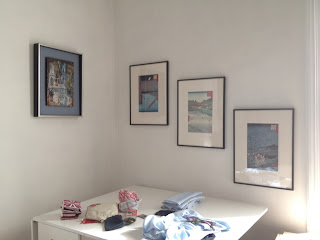The craft room is now in use! Originally our elder daughter's bedroom, this room became a spare bedroom/sewing room, then a spare bedroom/sewing room /toy room for our grandchildren. For six months of last year it held 28 storage boxes full of our kitchen while our extension was built - and served as a place to cook our meals on a sandwich press.
It has now been cleared and a huge wall-to-wall, floor-to-12ft ceiling wardrobe installed to take some of our off-season clothes and all my stitching gear. We cleared some bookshelf space by culling about 400 books and then stripped and painted the walls. All my craft books/magazines are now accessible on the bookshelf.

I didn't take photos of the room before this year. I did take a few of my old storage and the room packed up ready for the wardrobe to be installed. The wide-angle lens needed to fit in the whole wall (or nearly) distorts the shape.
It is even harder to take shots of the whole finished room, especially as the wardrobe has one mirrored door. The two below, taken from the doorway, and the corner opposite the door give an idea.



More than half the storage is for my craft.
I have divided my stash into large pieces of fabric, stacked on shelves, and smaller pieces - sorted into baskets or boxes and labelled. My embroidery frames fit on one shelf - except for my standing floor frame, which goes into the high section already made up.
One drawer holds my store of cards made from my photographs, three hold embroidery kits and three hold wool.


My threads go in the Japanese drawers on a shelf below the fabric.
I still have a large footstool filled with fabric - but that can gradually be absorbed.
It is a terrific, workable space and makes measuring, cutting out, finding things and machine stitching very easy and comfortable.
I love the light and cleanness of it - and some of my favourite paintings and Japanese prints.
I am already working on a number of projects that are made easier by the space.
I am really pleased and grateful.
More on the projects soon.
 I am trying to use up some of my stash of wool - and thought I should make something for my other grandchildren after the fox cowls. I found one and a half 200gm balls of Bendigo Woollen Mills' Harmony in a blue (Wisteria) that I thought my grandson would wear in a hat - especially if I knitted a matching one for his father.
I am trying to use up some of my stash of wool - and thought I should make something for my other grandchildren after the fox cowls. I found one and a half 200gm balls of Bendigo Woollen Mills' Harmony in a blue (Wisteria) that I thought my grandson would wear in a hat - especially if I knitted a matching one for his father.



























